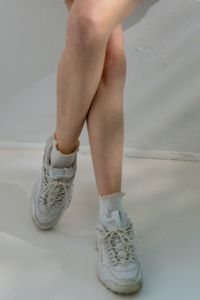We often think of aches and pains as the first sign of spinal trouble. Other symptoms may present without significant pain (at first). Here are three sneaky symptoms to look for, and when you should talk to your chiropractor.
1. Uneven Shoulders & Hips
Stand up straight and look in a mirror, preferable a full-length one. Are your shoulders even with each other? If not, or if you have to try to make them even, it could be a sign that your spinal curves aren’t where they need to be. Now find the top of your hip bones on both sides and press on them with your fingers so you can get a clear view. Are they even with each other? It’s common for people with uneven hips to have uneven shoulders, but you may have just one or the other. Uneven hips can indicate that your pelvis is tilted. A significant pelvic tilt will often show up in uneven shoulders as well. Uneven shoulders without a pelvic tilt can be caused by problems that affect the middle and upper spine, like scoliosis or posture issues.
The pelvis is the foundation of your spine, a pelvis that tilts to one side or is too far forward or back destabilizes the entire spine. Your muscles and ligaments will shorten or lengthen to adjust to the pelvic tilt, resulting in pain and stiffness. A leg length difference sometimes causes a pelvic tilt. It can also be caused by posture issues, too much sitting, or weak muscles. Bad posture or sitting for long hours can tighten hip flexors and other ligaments and muscles, pulling the pelvis out of alignment. Weak muscles aren’t good at holding your pelvis and spine in place. A leg length difference will cause the pelvis and the rest of the spine to tilt to one side. As your body tries to compensate for the pelvic tilt, your middle and upper spine will also rotate.
Mild scoliosis (a sideways curvature of the spine) can go undiagnosed throughout childhood. Later in life, you may notice that your shoulders are uneven, and you may have pain in your back, shoulders, and neck. Uneven shoulders are not always a sign of scoliosis. If you always carry things on one side of your body, sleep on one side, or have bad posture, your ligaments and muscles may tighten, pulling one shoulder down.
2. Numbness or Tingling in the Extremities
These symptoms can cause panic, and sometimes they are signs of an emergency. They can also be signs of disc problems in the spine. If you feel numbness or tingling in your left arm or one side of your face or experience numbness and tingling with chest pain, confusion, or loss of bladder control, you should seek emergency medical attention.
Numbness and tingling from a disc problem often occurs in the lower extremities, including in the glutes and thighs. It may also occur in the arms or hands. The numbness and tingling are often accompanied by shooting pains, typically described as sharp or burning sensations. You may also feel numbness or tingling in your hands or feet but not in other areas. The exact sensations and location will depend on where the damaged disc is and what nerves it’s affecting.
Spinal discs are cushy, fluid-filled structures between your vertebrae that absorb shock and allow for smooth movement. When one of these discs becomes damaged from an injury or wear and tear, it can cause pain and discomfort. Sometimes the disc slips and compresses nearby nerves. It can also become herniated and leak fluid that irritates the nerves and tissues around it. Pain, numbness, and tingling from a disc injury can vary from mild to debilitating. Sometimes these injuries heal on their own with home care, but they can also lead to chronic problems. Prompt treatment with spinal decompression therapy and adjustments can help you heal faster and avoid chronic pain.
3. Sore Knees or Ankles
Sore joints can be caused by osteoarthritis or rheumatoid arthritis, but in some people, they are caused by spinal alignment problems. A tilted pelvis or other abnormal spinal curvatures put a strain on your knees and ankles. If you know you don’t have arthritis or an injury and have noticed an increase in knee or ankle pain, your spinal may be to blame. Even mild knee discomfort should be investigated, especially if you don’t know the cause. In some people knee or ankle pain is the first, or only sign, of a bigger musculoskeletal problem. When left untreated, the extra wear and tear from spinal problems can lead to arthritis and even knee replacement surgery later in life.
When to See a Chiropractor
You shouldn’t wait until you are in terrible pain to seek treatment. Multiple studies have found that the level of pain does not always indicate the level of injury. A person with a mild spinal problem could experience severe pain, while someone with serious degeneration may experience no pain at all. If you feel stiffness, tingling, or notice that your body looks uneven or off-balance, you should be evaluated. Simple X-rays can show curvature issues, pelvic tilts, and compressed discs. Problems like these can cause more than just discomfort. They affect the nerves that control organs and your immune system. Digestive issues, menstrual problems, and frequent infections can all be caused by spinal problems. In women, a pelvic tilt can cause complications during pregnancy and delivery.
Our chiropractors in Kentucky use cutting-edge adjustment techniques to help our patients achieve optimal spinal health. We believe in a multi-faceted approach to spinal health that includes exercises, stretches, and home care in addition to adjustments. We will also provide advice on improving posture and other lifestyle changes that can prevent problems from reoccurring.
Give us a call today to find out what’s really going on with your spine and get a personalized treatment plan. Prompt treatment now can prevent further degeneration and systemic problems down the road.






